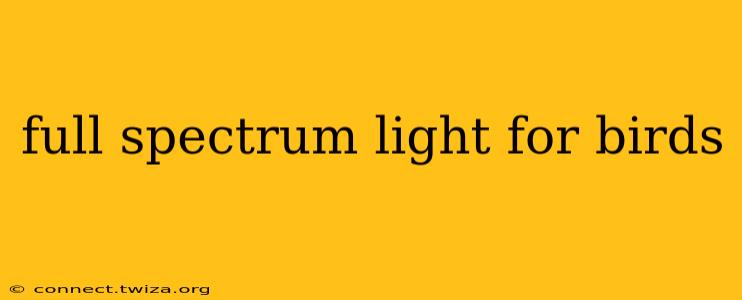Full spectrum lighting is becoming increasingly popular among bird keepers, but what exactly is it, and is it truly beneficial for our feathered friends? This comprehensive guide explores the science behind full spectrum lighting, its potential benefits and drawbacks, and how to choose the right lighting for your avian companions.
What is Full Spectrum Lighting?
Full spectrum lighting aims to mimic natural sunlight, providing a broader range of wavelengths than typical incandescent or fluorescent bulbs. Sunlight contains a wide spectrum of colors, from ultraviolet (UV) to infrared (IR), each impacting various biological processes. Full spectrum bulbs attempt to replicate this, including UV-A and sometimes UV-B light, although the intensity and spectral composition can vary significantly between different products.
Why Use Full Spectrum Lighting for Birds?
Many bird owners believe that full spectrum lighting improves their birds' health and well-being. The purported benefits include:
-
Improved Feather Quality: UV light is believed to aid in the production of certain pigments crucial for vibrant feather coloration and overall feather health. Birds with dull or unhealthy plumage may experience an improvement with full spectrum lighting.
-
Increased Vitamin D3 Production: Birds, like humans, need vitamin D3 for calcium absorption and strong bones. Exposure to UV-B light triggers vitamin D3 production in the skin, although the amount produced by artificial UV-B lights is often debated and varies greatly.
-
Enhanced Behavior and Mood: Natural daylight cycles influence a bird's circadian rhythm, regulating sleep patterns and behavior. Full spectrum lighting can help mimic these cycles, potentially leading to more active, alert, and happy birds. However, this effect can also be achieved by providing a suitable day/night cycle with standard lighting.
-
Stimulation of Breeding Behaviors: In some bird species, increased UV light exposure during specific times of year can potentially stimulate breeding behaviors. However, it's crucial to note that this isn't a guaranteed effect and other factors are far more influential.
What are the Drawbacks of Full Spectrum Lighting?
While the benefits are tempting, it's important to acknowledge some potential drawbacks:
-
UV-B Light Intensity: Excessive UV-B light can damage a bird's eyes and skin. It's crucial to choose bulbs with appropriate UV-B output and ensure they are placed at a safe distance.
-
Cost: Full spectrum bulbs tend to be more expensive than standard lighting options.
-
Heat Generation: Some full spectrum bulbs produce more heat than standard bulbs. This is a significant concern in warmer environments and needs careful consideration, particularly for smaller enclosures.
-
Not a Replacement for Natural Sunlight: While full spectrum lighting attempts to mimic natural sunlight, it cannot fully replicate it. Natural sunlight is rich in variation and intensity, unlike most artificial light sources.
What Type of Full Spectrum Light is Best for Birds?
Choosing the right bulb requires careful consideration of several factors:
-
UV-B Output: The amount of UV-B light produced significantly impacts vitamin D3 synthesis and overall effectiveness. Check bulb specifications for appropriate levels. Excessive UV-B can be harmful.
-
Bulb Type: Different types of bulbs (e.g., fluorescent, LED, incandescent) offer various benefits and drawbacks concerning energy efficiency, lifespan, and UV-B output. LEDs generally offer longer lifespans and energy efficiency.
-
Placement: Ensure the bulb is positioned at a safe distance from the bird to avoid overheating or excessive UV-B exposure.
-
Enclosure Size: Choose a bulb with appropriate wattage and output for the size of the bird's enclosure.
How Much UV-B Light Do Birds Need?
The UV-B requirements vary dramatically depending on the bird species. Some species require more UV-B than others for optimal health, feather development, and Vitamin D3 synthesis. It’s crucial to research the specific needs of your bird species. Overexposure to UV-B light can lead to health problems.
Do All Birds Benefit from Full Spectrum Lighting?
While full spectrum lighting offers potential benefits for many bird species, it's not universally beneficial. Some birds may not show any noticeable improvement, while others might even experience negative effects from improper usage. Always prioritize the species-specific needs and consult with an avian veterinarian before implementing any significant changes in lighting.
Conclusion:
Full spectrum lighting can be a valuable addition to a bird's environment, potentially improving feather quality, promoting better behavior, and supporting vitamin D3 production. However, careful selection of the appropriate bulb, careful placement, and awareness of potential drawbacks are crucial for ensuring its safe and effective use. Always consult with an avian veterinarian to determine the best lighting solution for your specific bird species and setup.
